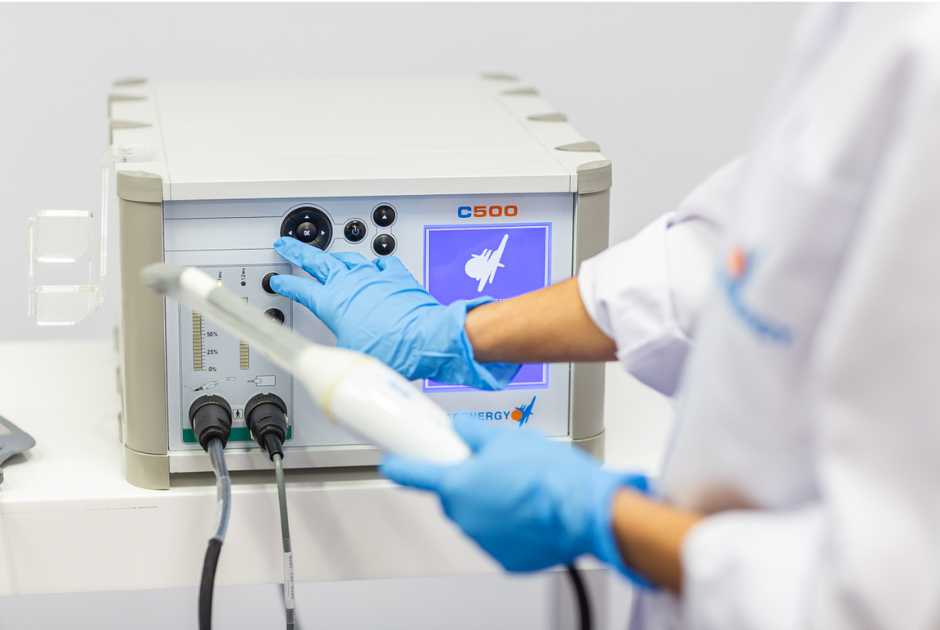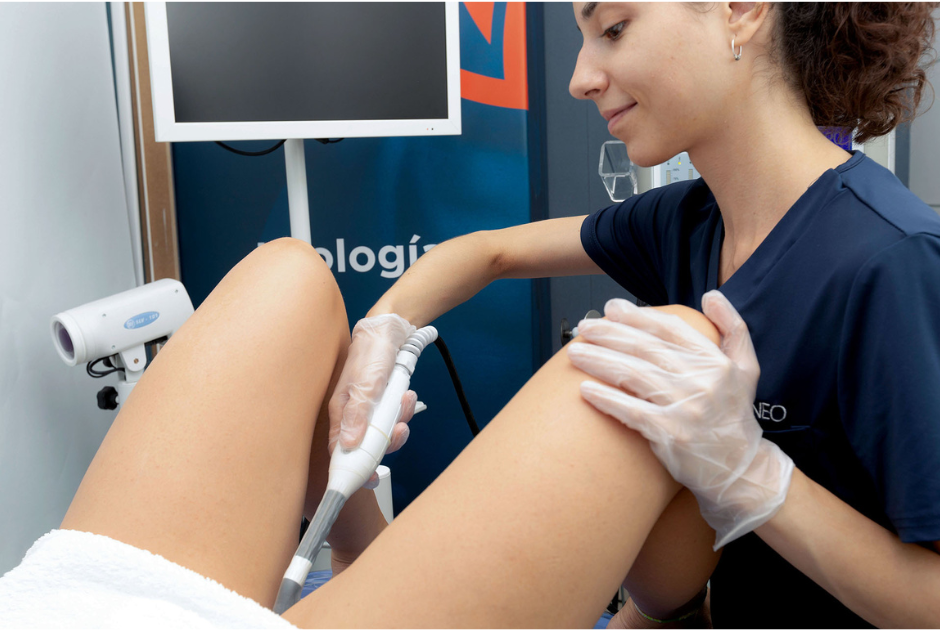
Menopause, a natural phenomenon in a woman ‘s life, marks the cessation of the ovarian function which tends to happen around the age of 50. Nevertheless, this does not imply the end of a woman ‘s active and social life, but a new stage during which she can keep on fully enjoying her professional and personal life.
In this article, we’ll explore how physiotherapy can play a key role in the treatment of menopause-related symptoms, especially those related to the genitourinary syndrome, by offering scientifically supported solutions.
Prevalence of the genitourinary syndrome during Menopause
There is a noticeable prevalence of genitourinary syndrome in menopausal women. According to studies, between 50% and 36% of women going through menopause experience genitourinary symptoms. Considering the increase in life expectancy and Spain ‘s aging population, these symptoms have become increasingly more relevant.
By 2050, Spain is expected to become the world ‘s most aged country, with 40% of the population aged 60 or more. This demographic reality urges us to find an effective solution for the treatment of genitourinary syndrome. Physiotherapy emerges as a valuable option, especially considering the saturation of the public health ‘s gynecology services.
Menopause is just another stage in a woman ‘s life. In the last couple of years, a menopausal woman ‘s lifestyle has changed significantly. If before a woman was stigmatized and had to face the physical and mental changes almost with resignation, nowadays a woman no longer needs to accept the symptoms that accompany the arrival of menopause with resignation.

During this period, hot flashes, decreased libido, irritability and memory loss are very common. However, we want to point out the relevance of genitourinary symptoms, as those can significantly alter life quality.
What is genitourinary syndrome?
Genitourinary menopause syndrome is the whole of signs and symptoms associated with the reduction of estrogens and other sexual hormones during menopause.
This hypoestrogenism can occur in other situations as well, such as for instance surgical menopause, the use of certain medicines or other factors such as hypothalamic amenorrhoea.
As a matter of fact, this syndrome was defined as a substitute for what was previously called vaginal or vulgovaginal atrophy.
Symptoms of genitourinary syndrome
As the estrogen levels reduce, the epithelium that covers the urogenital organs becomes thinner and the lubrication and tissue support diminishes. This generates other associated symptoms, the most common one being vaginal dryness, which most women define as the most uncomfortable of all symptoms.

But vaginal dryness isn’t the only symptom. Other common symptoms are reduction of vaginal elasticity, increase of the vaginal pH, changes in the vaginal flora, insufficient lubrication during sexual activity, dyspareunia, as well as itchiness and irritation, poscoital bleeding and reduction of sexual desire.
Furthermore, tissue damage does not only ocurr on a vaginal level, but also in the area of the urethra, generating symptoms similar to those of the urgency to void even at night time, often accompanied by pain and/or itching.
At this moment in life, prolapses of different pelvic organs start appearing as well, such as bladder prolapse. Many of these pathologies are caused by a bad recovery after obstetric procedures, combined with the loss of support of the connective tissue. Unfortunately, 40% of the female population suffers from some kind of prolapse after giving birth.
Unfortunately, genitourinary syndrome has chronic and progressive evolution, significantly reducing life quality.
Nowadays, many young women suffer from these symptoms after undergoing chemo and / or radiotherapy as well as women experiencing early menopause due to the intake of certain medicines. These womens’ symptoms become worse when natural menopause appears.
Physiotherapy: Integral therapy of genitourinary syndrome
Physiotherapy has proven to be a key discipline for the treatment of genitourinary symptoms associated with menopause. Physiotherapists specialized in pelvic floor issues play a vital role in its treatment and the improvement of menopausal womens’ life quality.
How to treat genitourinary syndrome?
When a woman is diagnosed with this syndrome, first of all she needs to make some lifestyle changes: quit smoking (tobacco increases the estrogenic metabolism), maintain an adequate weight and practise sports regularly.

More conventional medicine tends to treat genitourinary syndrome focussing on the symptoms only:
- If the symptoms appear during sexual intercourse, the use of lubricants and / or estrogens will be recommended.
- If the symptoms do not appear during sexual intercourse but even when walking, the use of lubricants will be recommended during intercourse and hormonal substitute therapy will be added as well..
- Should a vaginal prolapse occur during the menopausal process, certain exercises will be recommended (as is also the case for urine loss), as well as the use of a uterine pessary that acts as an artificial support. In more extreme cases, a uterine mesh is surgically implanted.
Genitourinary syndrome causes the epithelium to become thinner, paler and dryer, which can cause vaginal shortening, changes in the microbiota and reduction of the blood flow.
Also, collagen fibers can become fibrotic and elastin fibers can fragment, reducing the hydration of the vaginal mucosa and the production of intercellular hyaluronic acid which generates a fine-layered epithelium.
This is why therapies that stimulate neocollagenesis obtained such good results. And Capenergy has second generation radiofrequency devices that are perfect for this kind of therapies.
For the treatment of the symptoms of genitourinary syndrome, specialized pelvic floor physiotherapy is vital, as part of the conservative treatment of the symptoms (preventive, non-invasive and non-surgical), clearly aimed at improving proprioception, recovering muscle tone and normalizing connective tissue.
Treatment of genitourinary syndrome with Capenergy radiofrequency
The application of Capenergy radiofrequency has proven to be an efficient tool for the treatment of the symptoms of genitourinary syndrome.

The use of advanced TECAR Evolution CAPENERGY technology, specifically with the C500, presents itself as an exceptional ally for physiotherapists that specialize in pelvic floor issues. This innovative approach goes far beyond the traditional manual techniques and exercises, offering significative results in the treatment of genitourinary syndrome.
C500 Urogine is a radiofrequency device that comes with a patented intracavitary probe, equipped with a temperature sensor. Its precise anatomical shape enables a three-dimensional 360º interaction with the patient. It allows performing specific movements to stimulate the internal muscles, combining stimulation and pressure according to the physiotherapist’s indications.
Physiotherapy is crucial in the prevention and follow-up and CAPENERGY’s technology makes sure that the pelvic floor remains biologically active, assuring a complete vascularisation otherwise hard to achieve.

In reality, manual techniques and exercises alone are insufficient in the long run. This why the use of a C500 radiofrequency device, with intracavitary MJS probe, allows carrying out an intracavitary treatment while knowing the temperature that’s being applied, thus guaranteeing the stimulation of collagen production. And some other benefits that can be obtained are:
- Increase of type 1 collagen and elastin
- Increase of tissue trophism
- Stimulation of Bartholin’s glands to stimulate lubrication and hydration
- Increased blood circulation
- Reduction of the inflammatory process
- Powerful analgesic effect
- Regulation of the muscle tone
- Important increase of the cellular metabolism
- Reduction of fibrotic tissue
Without any doubt, Capenergy is an efficient solution for patients suffering from genitourinary syndrome of menopause.
Would you like to know more about Capenergy and how to treat the symptoms of genitourinary syndrome? Request a free demo.